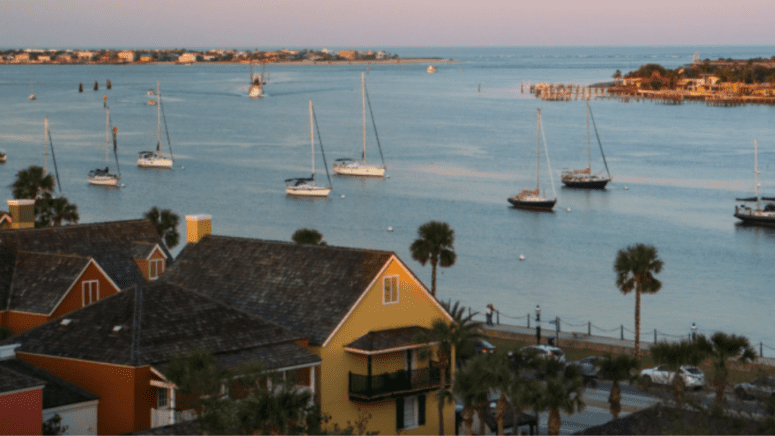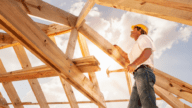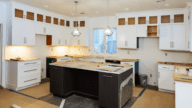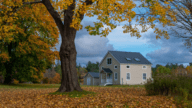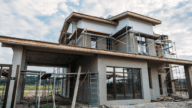What’s the Average Cost to Build a House in Florida?
- Published on
- 15 min read
-
 Syndie Eardly, Contributing AuthorClose
Syndie Eardly, Contributing AuthorClose Syndie Eardly Contributing Author
Syndie Eardly Contributing AuthorSyndie Eardly is a veteran journalist and legal reporter with more than 20 years’ experience, writing for the real estate, mortgage and title insurance industries. She has helped launch several online publications, including DoddFrankUpdate.com, which was launched after the Great Recession to cover the many legislative efforts that followed. Syndie resides in Cleveland, Ohio, where she enjoys the lively restaurant scene, spending meditative time on the beautiful shores of Lake Erie, and hiking in the Emerald Necklace and Cuyahoga Valley National Park.
-
 Sam Dadofalza, Associate EditorClose
Sam Dadofalza, Associate EditorClose Sam Dadofalza Associate Editor
Sam Dadofalza Associate EditorSam Dadofalza is an associate editor at HomeLight, where she crafts insightful stories to guide homebuyers and sellers through the intricacies of real estate transactions. She has previously contributed to digital marketing firms and online business publications, honing her skills in creating engaging and informative content.
The Sunshine State gives newcomers plenty of options to build a home, with a wide variety of architectural styles and price ranges to choose from. With one of the longest coastlines of any state in the U.S. — second only to Alaska — beach lovers can find lots of communities in which to build, from Key West to Pensacola, while others flock to Miami, Orlando, or Jacksonville for more urban living. But what’s the cost of building a house in Florida?
Florida ranks sixth among the cheapest states to build a home. Thanks to the state’s low labor costs, building a home can be affordable in many areas, averaging $142 per square foot.
To help you navigate the ins and outs of building in Florida, we spoke with experienced agent Myles Reeves, part of Tim Ekelund’s team in Pensacola, Florida, who specializes in beachfront, condominium, and investment properties.
Average cost to build a house in Florida by city
Building a home in Jacksonville is the least expensive option, with an average cost of $114.28 per square foot, while building a home in Miami is the most expensive option, at an average cost of $138.34 per square foot. Here’s a look at cities in Florida and the average cost per square foot to build a home, complete with estimates from ProMatcher:
| City | Cost per square foot |
| Jacksonville | $114.28 |
| Miami | $138.34 |
| Orlando | $120.93 |
| Panama City | $122.28 |
| Tampa | $112.81 |
Breakdown of costs to build a house in Florida
No matter which state you’re in, the steps involved in building a house will vary depending on whether you’re buying a tract home — which is when a builder has bought a large tract of land to divide into lots and build out several homes — or you’re building a custom home.
Keep in mind that the price ranges we’re providing are general estimates. Your real estate agent and, eventually, your builder can give you more specific pricing information.
Here’s a look at the average costs of each phase of building (we’ll dive into the details later):
| Building Phase | Average cost (2025) |
| Foundation | $4,039 to $14,848 |
| Framing | $1,408 to $7,667 |
| Roof | $5,867 to $13,210 |
| Siding | $5,561 to $17,624 |
| Appliances | $10,875 |
| HVAC system | $10,000 |
| Plumbing system | $2.50 to $15 per linear foot |
| Electrical system | $7,286 to $13,257 |
| Building permits | $1,000 to $3,000 |
| Finishes and fixtures | $30,181 to $321,021 |
Buying a plot of land ($60,738 per acre)
Currently, there are over 30,000 land listings in Florida, at an average price per acre of $87,551. Of course, the cost of land will be quite different from community to community.
For example, a 1-acre residential lot in Marion County is listed for $34,888, while a 1.12-acre lot in Lee County is priced at $175,000. Meanwhile, a 1.1-acre property in Nassau County is on the market for $269,000. These listings highlight the wide price variations across different areas.
Reeves says many, if not most, of his clients who are looking to build in Florida are new to his area. He recommends that clients spend some time in the area where they want to live and visit multiple cities, towns, and neighborhoods before deciding where they want to buy.
“Each of our cities and towns has a unique and distinct vibe,” he notes. “I recommend that you immerse yourself in the area to get a feel for what is going on. In most of these cities, land is readily available. We are not hurting for land listings in Florida. Buyers should take their time to get the land that is best suited to their needs and lifestyle.”
Once you’ve determined where you want to build, get your finances ready for the costs of new home construction.
Foundation ($4,039 to $14,848)
Foundation costs will vary depending on whether you’re pouring a slab or digging a basement, but a typical price range is between $4,039 and $14,848.
In Florida, very few homes have basements, as most areas cannot accommodate them. This is due to Florida’s aquifer system, an underground network of porous rock and sediment that stores and supplies fresh water throughout the state. Digging deep into the aquifer system can trigger a sinkhole, so most builders won’t even consider it.
Most inland homes are built on slabs. But if you are buying waterfront property, your house will likely be built on stilts.
“Should you buy a waterfront home or anywhere there are flood concerns, your house is going to be built on stilts,” Reeves says, noting that people coming from the Midwest or Northeast regions are always a little surprised by that construction feature, but it is standard along the coast to ensure homes can weather storm surges.
Framing ($1,408 to $7,667)
Framing is when the sticks go up and a structure actually starts to take shape. Expect to pay between $1,408 and $7,667 for this phase of building a house in Florida.
Framing costs tend to vary due to the size of the home and the complexity of its design. A one-story home with 2,000 square feet of living space will generally be less expensive to frame than a two-story home with the same square footage.
The threat of strong tropical storms and hurricanes in Florida adds to the cost of building a home due to the required safety features.
“Homes in Florida need to be wind-rated for 150 miles per hour,” Reeves explains. “On the builder side, that adds to the cost. But after you’ve been through a couple of hurricanes, you think whatever they do to keep me safer, I am for it!”
Reeves says windows and doors have to be wind-rated as well, and homes are often outfitted with further hurricane protections, such as shutters that go over the windows. The good news, according to Reeves, is that your insurance company will take into account any wind mitigation protections built into the home and your insurance costs should reflect that.
Roof ($5,867 to $13,210)
Roofing doesn’t come cheap — whether you’re putting one on a new house or replacing the roof on an existing home. The costs of a new roof typically range from $5,867 and $13,210.
While asphalt shingles are the most common and affordable roofing style in Florida, metal roofs are more practical for the climate. Not only are metal roofs more able to endure hurricane winds, but they are also better at reflecting heat away from the home, providing valuable insulation against the intense sunlight in the Sunshine State.
Concrete or clay tile roofs are a solid option. Similar to metal roofing, they’re highly wind resistant. Although expensive, the longevity of a tile roof makes it worth the investment. On the downside, tiles are subject to cracking or breaking, but they are easy to replace.
When deciding what style of roof you prefer, you must consider the cost of the various types of roofing materials. Here are some general estimates:
- Asphalt shingles: $3 to $7 per square foot
- Metal: $7 to $13 per square foot
- Clay tiles: $10 to $20 per square foot
- Slate or stone: $15 to $30 per square foot
Siding ($5,561 to $17,624)
Siding is another big variable: Are we talking vinyl, wood, brick, concrete, stone, stucco or something else entirely? Siding costs range between $5,561 and $17,624, with vinyl or engineered wood siding typically costing up to $30,000.
According to the National Association of Homebuilders, stucco and vinyl were the most common siding materials used on new single-family homes built in 2023, accounting for 27% and 26% of properties. Fiber cement siding such as Hardiplank or Hardiboard and brick or brick veneer were not far behind, at 22% and 18%, respectively.
Only 5% of new homes nationwide use wood siding. Once the most common siding material in the U.S., wood is not a good choice for the subtropical Florida climate, as it consistently underperforms in light of threats from humidity, rainfall, heat and sun exposure, and hurricanes.
Vinyl is likely the most common siding choice due to its affordability, ease of installation, and variety of colors. It’s also waterproof, fireproof, termite-proof, and resistant to denting, making it a dependable choice for Florida homeowners.
One of the most expensive options, but arguably the most durable, is fiber cement board. It stands up well against rain and wind and is fairly easy to repair. The downside, however, is that it’s very expensive to install, nearly twice the cost of vinyl.
Here is a rough comparison of various siding materials, but remember that installation costs must be taken into consideration as well:
| Material | Cost per square foot |
| Stucco | $8 – $13 |
| Brick | $8 – $21 |
| Fiber Cement | $5 – $10 |
| Aluminum | $5 – $9 |
| Stone | $22 – $45 |
| Vinyl | $5 – $11 |
| Wood | $5 – $15 |
Appliances ($10,875)
You guessed it — appliance pricing also varies widely. Depending on the brand, functionality, finish, and so on, you’ll spend an average of $10,875 on appliances for a new construction home, but the costs can definitely go up to $24,400 or more on a high-end appliance package.
HVAC system ($10,000)
The installation of a new heating and cooling system could cost between $5,000 and $15,000 depending on the unit type, size, and brand, although $10,000 is the average. The installation cost may range from $3 to $7 per square foot.
Plumbing system ($2.50 to $15 per linear foot)
On average, installing new pipes costs $2.50 to $15 per linear foot, not including fixtures like sinks and toilets.
Electrical system ($7,286 to $13,257)
The cost to wire an entire new construction home, including material and labor, is, on average, between $7,286 and $13,257.
Building permits ($1,000 to $3,000)
Permits vary by state, city, and county, but they typically cost between $1,000 and $3,000.
“The permitting process is pretty straightforward in Florida,” Reeves advises. “You apply through the city where the land is located. Zoning is more of a concern. Make sure the land you are buying is zoned correctly and has proper runoff because as flat as we are, drainage is paramount.”
Building permit fees are determined by the municipality and vary greatly across the state of Florida. Often, the fees are calculated based on the square footage, so the larger the project, the more expensive the building permit will be. It’s advisable to research these numbers before you kickstart your project.
Finishes and fixtures (variable)
Finishes and fixtures comprise everything from countertops to sinks and lighting to flooring. Needless to say, pricing varies widely and depends heavily on your design preferences.
Average carpet installation costs can start at several hundred dollars and go up to $2,812, while hardwood flooring installation starts at around $2,469 and tops out at $7,032.
Laminate countertops tend to range from $841 to $1,739, while a natural stone like granite ranges from $2,000 to $6,000.
Building a custom home vs. a home in a development
As a general rule, building a custom home that is tailored to your every need will be more expensive than buying a tract home from a builder. On average, building a tract home in Florida will cost $125.41 per square foot, while going the custom route could add 20% to 50% to that estimate, significantly increasing the overall cost.
“For clients who have a very specific vision, building a custom home can be the most logical option,” Reeves says. “If you are a little more cost-conscious, it probably makes more sense to purchase a home in an established neighborhood that is being developed by a builder.”
Building a custom home will also require you to assemble a team of experts to design and build the home from start to finish. Here are the team members you will need and a breakdown of what they might cost you:
Architect (10.46% of the final build cost)
Hiring an architect will be integral to making your vision come to life when building your custom dream home. Before you begin your search for the right architect, get clear about what you are looking for. Be sure to do your research and ask your network for recommendations for architects in your area with experience designing the kind of home you are looking to build.
The cost of hiring an architect could make up anywhere between 5% and 20% of the final build cost. For a 2,000-square-foot home in Florida, with a final build cost of $372,000, that would amount to $18,600 to $74,400.
In Florida, the average architect charges approximately 10.46% of the total construction cost. Some architects will opt to charge by the hour or per square foot of the build for their services, but this is less common.
General contractor (10% to 20% of the final build cost)
A general contractor will oversee the entire process of building your custom home and can be a substantial part of the cost to build a house in Florida. They will also be responsible for hiring and paying subcontractors, vendors, and construction workers.
General contractors typically abide by a cost plus fixed-fee contract, which accounts for the cost of the labor and materials plus a negotiated fee for the general contractor. The general contractor’s fee usually makes up 10% to 20% of the final cost of the build.
Additional costs of building a home in Florida
As previously mentioned, building a custom home often comes with additional costs. Your agent can help you determine more accurate costs — these are average figures provided to give you an idea.
Land survey ($376 to $768)
Land surveys, which identify your property lines and land features, cost roughly $376 to $768.
Excavation and grading ($3,990 and up)
If you’re opting for a tract home, the land price will be rolled into the overall cost of building a home. If you’re buying a lot on your own and then building a custom home, you must consider the cost of excavation and grading, which will vary depending on the size of your build and the amenities you want to add to your property.
General excavation may cost around $3,990, but you may also want to consider typical costs for excavation and grading for various aspects of your build:
- Basements (rare in Florida): $1,500 for smaller homes; up to $15,000 for larger homes
- Patios and driveways: $1,000 to $2,500
- In-ground swimming pool: $400 to $1,500
- Land clearing: $40 to $100 per cubic foot
- Trenching for piping: $1,500 to $10,000
If you are purchasing in a development farther away from the city, you will likely find more ranch-style homes. If you choose a builder who is developing in a city, you will most likely see more two-story houses because it is more efficient to get the square footage in a smaller footprint.
 Tim Ekelund Real Estate AgentClose
Tim Ekelund Real Estate AgentClose Tim Ekelund Real Estate Agent at 1st Class Real Estate Gulf Coast Currently accepting new clients
Tim Ekelund Real Estate Agent at 1st Class Real Estate Gulf Coast Currently accepting new clients
- Years of Experience 11
- Transactions 661
- Average Price Point $255k
- Single Family Homes 606
Common styles of homes in Florida
When it comes to choosing a style of home in Florida, you are only limited by your imagination. But to some extent, your choice may depend on your location, as each area of Florida has its own cultural influences, limitations, and environmental issues.
Cultural influences vary widely in Florida, and the architecture reflects an eclectic mix of European, South American, and Caribbean influences. Styles include Mediterranean, Spanish, Art Deco, Craftsman, Coastal, Ranch, Traditional, Contemporary, and Victorian.
“If you are purchasing in a development farther away from the city, you will likely find more ranch-style homes,” Reeves says. “If you choose a builder who is developing in a city, you will most likely see more two-story houses because it is more efficient to get the square footage in a smaller footprint.”
Reeves notes the most common floorplan consists of three bedrooms and two bathrooms and “will almost always include a porch or a Florida room in the back.”
Many of the preferred architectural styles, though different on the outside, share some common features due to the climate. Think open floor plans, large windows, high ceilings, and ample outdoor features like porches, decks, and Florida rooms, which are light-filled, enclosed living spaces with outdoor views. This is especially true of Coastal, Traditional, and Contemporary styles.
Art Deco shares some of these features and is one of the most iconic architectural styles found in Florida, primarily in Miami Beach. Its sleek, geometric lines, metal roofs, and distinctive colors complement oceanfront living.
More affordable options for building a home in Florida
While going with a bare-bones building strategy can get you into a new construction home for less, cheaper isn’t always better. Shoddy build quality will inevitably lead to problems down the road.
Anything from a leaky roof to poor sound insulation can be a frustrating discovery when you’ve only been in your new home for a few months. There’s value in creating a home you genuinely want, not just one you’re settling for.
Alternative home-building options can give you more for your money and offer valuable flexibility during the construction process.
Tiny homes ($30,000 – $60,000)
A tiny house is usually 600 square feet or less in size. It’s not ideal for large families, but building a tiny house can be faster and more affordable than a conventional home if a smaller space fits your lifestyle. On average, tiny homes cost between $30,000 and $60,000 to build.
Tiny homes are popular in Florida, as they present an affordable option for retirees migrating to a warmer climate or first-time homebuyers looking to get a foot on the property ladder.
Tiny home communities are popping up all over the state — Peacewind Cottages in Cocoa and Gracious Tiny House Park in Okeechobee, for example.
The added amenities are perhaps the biggest draws of these tiny communities, and the homeowners share the costs. Expect community gardens, dog parks, or fitness areas like the one at Lakeshore in Oxford, Florida.
If you want to build a tiny home instead of purchasing one from a developer, be sure to do your research. Each county has its own specific rules and regulations regarding size and construction.
Reeves says there is a lot of excitement and interest around tiny houses in his area but they typically are not being built as primary residences. “A lot of people are using them as an accessory dwelling unit (ADU), to rent out as an Airbnb, or as a secondary residence for family members,” he says.
Modular and prefabricated homes ($160,000)
Modular and prefabricated homes are generally less expensive because they are constructed in a factory setting where tasks are managed more efficiently. This means less material waste, a shorter build time, and better quality control.
According to ModularHomes.com, the average price for a 1,800-square-foot modular home is currently $160,000, well below the average cost to build a single-family home in Florida.
While the price of a modular home in Florida is less expensive than a tract home or custom build, the price will inevitably vary depending on the style and square footage.
As modular construction has evolved, the variety of housing types and styles has grown too. In a state like Florida, which is subject to unpredictable and extreme weather, modular construction can be a much more efficient way to build. This is true of manufactured housing as well, which is estimated to make up nearly 10% of the total housing stock in the state.
Reeves acknowledges that most established neighborhoods do not allow manufactured homes. For those interested in building their own manufactured home, he recommends looking in more rural areas for plots of land zoned for such purposes.
Is it cheaper to buy or build a home in Florida?
In Florida, the average cost of building a home is $300,000, with projects costing $270,000 to $560,000. Meanwhile, the median single-family home costs $400,000. That means building a new home is typically $100,000 cheaper than buying an existing home.
While building a home will almost always come with a higher price tag upfront, there are some long-term savings that new construction homeowners enjoy:
- Energy efficiency: Newly constructed homes are generally more energy efficient than older homes. This is partially due to more strict energy regulations and better insulation and windows in new homes.
- New home warranties: New construction homes are often covered under builder warranties for a specified period of time. When purchasing an older home, most of the key systems, such as the HVAC, roof, and plumbing, will be older and no longer covered under any kind of warranty.
- Fewer maintenance costs in the first few years: With a newer home, you can count on your HVAC, plumbing, electrical system, and more to be functioning properly with little required maintenance in your first few years of homeownership. Older homes will likely have older roofs and older systems, requiring you to pay for replacement much sooner.
- New homes might be cheaper to insure: Many homeowners insurance providers offer discounts for new construction homes due to the lessened risk of damages common in aging homes.
Get started on building your dream home
Building a house in Florida isn’t cheap, but knowing the costs upfront can save you a lot of stress. From materials to labor, every choice adds up. Plan wisely, budget smart, and stay flexible. Whether you’re going for something simple or high-end, a well-thought-out approach makes all the difference.
An experienced real estate agent can be your greatest asset in identifying a property that meets your needs and finding a builder who can craft a home that fits your specific requirements and budget.
Header Image Source: (Kristin Wilson / Unsplash)
- "How Much Does It Cost to Build a Home in Each State?," Today's Homeowner, Kristina Zagame (February 2025)
- "What Is the Most Common Siding Material for Single-Family Homes?," NAHB (July 2024)
- "How Much Does It Cost To Install Siding?," Forbes, Nick Cellucci (December 2024)
- "How Much Does It Cost To Install An HVAC System?," Forbes, Rosanne Schipper (December 2024)
- "Florida's Tiny Home Rules and Regulations: Everything You Need to Know," Tiny House (January 2024)
- "In the crosshairs of the climate and housing crises," WUFT, Jack Lemnus (May 2024)
